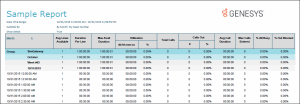- Contents
Interaction Reporter Help
DNIS Detail Report
The Call Detail by DNIS report displays a detail of inbound calls for each day in the given range. The DNIS Detail Report includes: connected date, caller ID, remote name, remote number, local user, station ID, call duration, and number of calls.
Note
Analysis of database requirements of IC demonstrates that the collection
of DNIS statistics increases the amount of data collection. To activate
DNIS collection in the Queue Period Statistics table, go to the Report
Configuration page of the Server configuration dialog in Interaction Administrator.
From the Report Configuration page, select the Generate
DNIS reporting data check box.
Parameters
You specify a range of dates, times, DNIS, and site IDs to include in the report. IC sorts this report by DNIS, by date, and then by time.
Note
If you enter a range for one of these specific parameters (caller IDs,
dialed numbers, DNIS, and user IDs), and a record included in this range
has a null value for any one of these parameters, then this record will
be excluded on the report. It is not possible to include these records
at this time.
|
Report Log Tables |
Interaction Administrator Unique Report Identifier |
|
CallDetail |
DNIS_DETAIL_NAME |
Sample report
Click on the image below to view a sample of this report.
|
Report Element |
Report Field or Value |
Field or Value Description |
|
DNIS |
DNIS |
The DNIS obtained from the network on any inbound call. |
|
DNIS Number of Calls |
Count(Connected Date) |
The count of the number of calls for the specified DNIS. |
|
Total Call Duration |
Sum (CallDurationSeconds) |
The total time of the calls with the specified DNIS. |
|
Avg. Duration |
Sum (CallDurationSeconds) / Count(Connected Date) |
The average amount of time for the calls with the specified DNIS. |
|
Date |
ConnectedDate |
The date and time for the call with the specified DNIS. |
|
Call ID |
RemoteNumberFmt |
The formatted version of the remote number, the external or extension number dialed. The digits or extension dialed to reach the remote party is displayed, if the remote number field in the database is blank, and an asterisk will follow it. The Caller ID is displayed if the direction is inbound and the remote number is blank, and two asterisks will follow it. NOCLID=No Caller ID; N / A=Not Available. |
|
Name |
RemoteName |
Calls that provide Caller ID information will use the calling party’s name. If the system did not receive notification of NOCLID and there is no Caller ID, then IC displays Unknown Name. |
|
User |
LocalUserId |
The user ID of the person receiving the call. This field could be blank if the user to receive the call was not logged into the system. |
|
Ext. |
LocalNumber |
The local phone number of the extension number receiving the call. |
|
Station ID |
StationID |
Identifier for the station used to receive the call. A value of system indicates that the call was not associated with a station. |
|
Call Duration |
CallDurationSeconds |
The duration of the call expressed in hh:mm:ss. |
|
Hold Time |
HoldDurationSeconds |
The duration that the call was in a hold status expressed in hh:mm:ss. |
Record Selection Criteria:
{CallDetail.ConnectedDate} in {?StartDateTime} to {?EndDateTime} and
{CallDetail.CallDirection} = {@CallDirection} and
{CallDetail.DNIS} in {?StartDNIS} to {?EndDNIS} and
{CallDetail.SiteId} in {?StartSiteId} to {?EndSiteId}
Formulas:
All times are expressed as hh:mm:ss. This formula is used throughout the report to convert seconds to hh:mm:ss. This formula is external to the report file.





